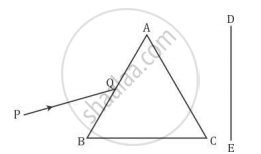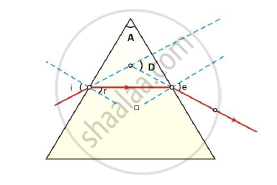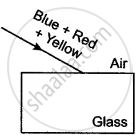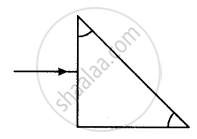Advertisements
Advertisements
Question
The frequency range of visible light is from 3.75 × 1014 Hz to 7.5 × 1014 Hz. Calculate its wavelength range. Take speed of light = 3 × 108 m/s.
Solution
Frequency f = 3.75 × 1014 Hz
Velocity of light (C) = 3 × 108 m/s
λ = `C/f`
= `(3 xx 10^8)/(3.75 xx 10^14)`
= `(3000 xx 10^5)/(375 xx 10^12)`
λ = `(8 xx 10^5)/(10^12)`
= `8 × 10^(5 - 12)`
= 8 × 10-7 m
= 8 × 10-7 × 1010 Å
= `8 × 10^(-7+10)`
= 8 × 103 Å
Also, f = 7.5 × 1014 Hz
λ = `C/f`
= `(3 xx 10^8)/(7.5 xx 10^14)` m
= `(3 xx 10^8)/(75 xx 10^13)` m
= `(300)/(75) xx (10^6)/(10^13)`
= `4 × 10^(6 - 13)`m
= 4 × 10-7
= `4 xx 10^(-7 + 10)`
= 4 × 103
= 4000 Å
∴ Wavelength range of visible light is 4000 Å to 8000 Å
APPEARS IN
RELATED QUESTIONS
A narrow beam PQ of white light is passing through a glass prism ABC as shown in the diagram.

Trace it on your answer sheet and show the path of the emergent beam as observed on the screen DE.
(i) Write the name and cause of the phenomenon observed.
(ii) Where else in nature is this phenomenon observed?
(iii) Based on this observation, state the conclusion which can be drawn about the constituents of white light.
In the following ray diagram the correctly marked angle are:

(a) ∠i and ∠e
(b) ∠A and ∠D
(c) ∠i, ∠e and ∠D
(d) ∠r, ∠A and ∠D
What are the seven colours seen in a rainbow?
The property of splitting of white light into its seven constituent colours is known as
In an experiment to trace the path of a ray of light through a triangular glass prism, a student would observe that the emergent ray
(a) is parallel to the incident ray.
(b) is along the same direction of incident ray.
(c) gets deviated and bends towards the thinner part of the prism.
(d) gets deviated and bends towards the thicker part (base) of the prism.
In the figure, a beam of light consisting of three colours blue, red, and yellow is incident on a prism and on a rectangular glass block respectively. Complete the diagram by drawings of the refracted and emergent rays.

In the diagram, a narrow beam of white light is incident on a right-angled isosceles prism. The critical angle of the material of prism for the yellow colour of white light is 45°. Complete the diagram to show the path of blue, yellow, and red colours of white light till they emerge out of the prism.

Match the Columns:
| Column ‘A’ | Column ‘B’ |
| The wavelength of red light | (a) 600 nm |
| (b) 700 nm | |
| (c) 500 nm |
Assertion: We can see the rainbow in the sky when the rain starts falling after a spell of bright sunlight.
Reason: The rainbow is formed due to the dispersion of light.
When sunlight passes through water droplets in the atmosphere it gets dispersed into its constituent colours forming a rainbow. A similar phenomenon is observed when white light passes through a prism.
Which colour will show the maximum angle of deviation and which colour will show the minimum angle of deviation?
